![]()
Bukit Tunggal School Revisited 2001
The year 1963.
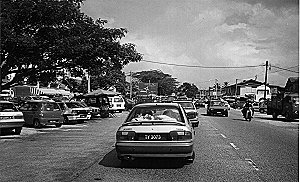 Batu Enam in 2000, the market place is on the left side of the road. In 1960's this view was a gravelled road for padestrians and cyclists, very rarely motorised vehicles, even motobikes, no electricity, telephone, or pipe water, not even their poles. Both sides of the road were lined with big trees, mostly chengal. The make-shift market was under the trees when it first moved from 'Atas Banggol'. Then some temporary structures were built on the left side of the road, because the right side was too close to the residentials. Then the temporary structures were made permanent, then the market place was made permanent with other peripherals structures. the current busy-ness began in 1980's when the 'forest' was repossessed for industrialisation. It began with The Tropical Veneer, a plywood factory in Banggol Air Lilih (Banggol Ma'Nong). With this factory, the people of my place began to learn to become self-degrading, in contrary to their elders who always stood on their feet to live: the pay was only three ringgit a day, but the most poisonous was it took to know somebody in order to became a slave in the factory. In Dec 1963 I passed this road twice a day, on my last frolick before leaving the place to be swallowed by my destiny. Today Batu Enam is still known for its many delicacies, but most of all as the most expensive place to buy food materials. The area now is swollen with "foreigners" bonded to the development activities, some of them even do not speak the local language, unlike those days when the only way to tell that one was a china was his not going to the mosque on Friday afternoon, and that she was a Mek cina when she had a short hair, the rest of their lives were fully local, including their swear words. Even I am myself now a "foreigner" in this place. |
In the beginning, the fun in Batu Enam was the market itself, the place to see where people were gethering. The market was then at 'Atas Banggol' (next to Wanawang's the timber lorry driver place), opposite the Surau Pak Cha (and the graveyard where my father's father was laid to rest) at the road beginning into the 'forest'. Every evening in Batu Enam market (except Friday evening) was like Monday and Thursday mornings in Tepoh Market. On many occasions I followed my mother to the market to buy sundries. There used to be many activities on the open ground in front of the market place; usually selling 'magic' medicine, such as one evening a kind of oil which, said the seller, would heal a cut instantly leaving no trace or scar. The seller demonstrated it by cutting with a knife ('cunningly') his own thigh, followed by a local stooge; I was not amused. That place also was a rendezvous point for villagers to go for wild boar hunting in the 'forest' when farmers found out that their padi, keladi and ubi were rampaged. Boys were cautioned to be let to follow (unlike squirrel hunting) because this would involve very sharp spear throwing, long parang wielding, and most of the rifle shootings. Two fierce/brave dogs were known at that time in the hunting party, under the guardianship of china Kiat (bicycle shop) who lived at the peripheral and never missed any hunting trips, on the MOU that the killed boar would be his/theirs to feast on; one was named MokMek, a brown female terrier, and another was name Eh, a spotted white alsatian male. I tried to follow once, with my brother, but only up to Wakaf Baru, after that I was scared, and the hunting party was deep into the forest. On other occasion, I heard that the Eh was badly injured in a fight with the boar, that it had to be carried to Kuala Trengganu vet. On another occasion, I heard that a stray bullet hit a youngester's lips, Wan Mokhtar (many years later married my cousin MekLah, AyahLi's daughter) who stayed at the back of Mak Teh Pah's surau.
In 1963, the market was in a new place. I did not remembered when they moved. The new place was along the opposite gravel road (the present day place) under the big trees of 'keradeh' ('keranji') and bamboo linings.
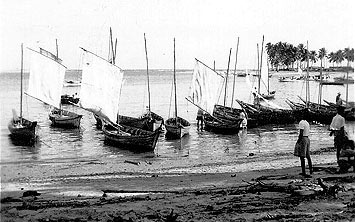 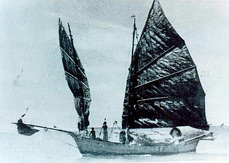 The 'bay' of Kuala Terengganu in late 1950 and early 1960, looking toward the open sea. The river mouth was so big that during monsoon season the water was so choppy. The boats were passenger-carrying to-and-fro Seberang Takir. Small boats carried small number of passengers. Bigger boats, the "perahu bedor" carried larger number of passengers and a lot more cargo, and a lot more safer. All were using sails to drive; it was impossible to row. In late 1960, diesel-driven boats were available; and they survived, unprogressed though, to these days and covering longer routes from upstream. The 'bay' of Kuala Terengganu in late 1950 and early 1960, looking toward the open sea. The river mouth was so big that during monsoon season the water was so choppy. The boats were passenger-carrying to-and-fro Seberang Takir. Small boats carried small number of passengers. Bigger boats, the "perahu bedor" carried larger number of passengers and a lot more cargo, and a lot more safer. All were using sails to drive; it was impossible to row. In late 1960, diesel-driven boats were available; and they survived, unprogressed though, to these days and covering longer routes from upstream. |
My brother finished his school two years ago, the year exactly everything was up to my parents' noses, and thus my brother began his trial of life. Although I was still at school, helping him was helping my parents, and throughout this period my schooling was entirely in the hands of my destiny. My brother would do any thing a normal boy would do, and I would help in any which a brother would. He began as a cook helper in Bukit Tunggal, a housing for a group of Indian labours. It did not last very long because, perhaps he preferred his own ways of doing things. He changed to 'trading'; first trading the 'dedak', the padi husk he baught as far as Kebor, and sell them in Tanjung market, Kuala Trangganu, by boat. I followed his steps too on many occasions; selling breads (value-added with my mother's srikaya recipe) on certain occasions such as during Film Unit visit show in Pengkalan Luas. The bread (the most delicious - slightly more expensive - was made by chinese in Pulau Kambing - otherwise from local makers, one was Nawi whose bakery was in front of AyahLi's place at Batu Enam, and I had some opportunity to befriend him in late 1960's) was good during Ramadan. One day in one season, my brother suddenly fall ill, and he could not continue to sell it that evening. My mother asked me to help, and I did. I rode the bicycle across the bridge towards Buluh Gading, through Paya Datu and back. At one house at the end of Paya Datu, they they wanted to buy only one piece, the cost was 15 sen for two pieces, and I had to allowed 7 sen in order to stop further argument on the half sen. Then with a bicycle my brother began more serious trading job, buying and selling fruits, even fish, in Batu Enam market. By then the Batu Enam market had been moved down past the four-junction to the road heading to Buluh Gading (the rumour was that the villagers reacted for disliking Wanawang, a timber lorry driver, disallowed a Parti Negara ceramah on the open ground in front of the market, also infront of his place). It was a make-shift market, no shelter or building; it was all under the shadows of big trees, the chengal mostly, and I remembered one 'keranji' tree. I helped him in the evening (Batu Enam market was an evening market), as a way to 'enjoy' out of schooling disinterests, but he always insisted me helping my mother at home. At one time I helped him on bicycle to buy 'langsat' in Gemuruh.
 My #6 son, at 10, in the scout uniform in 2002, my dream that never really came true. |
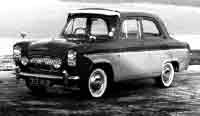 A Ford Prefect, a car, if we ever hardly see one. A green one, belonging to CheGu Nazir, was the only car I saw in the school throughout my six years in the school. |
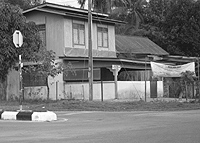 The premise today, of what was Kedai Mahmud in 1963. |
The Std Six Exam was around the corner. CheGu Manan the class teacher organised extra classes in the evening. When the morning class ended I would go to the lady teachers who was teaching in the afternoon session. They had bicycles, I asked her if I could borrow it to go home for lunch break to come back for the extra class, and they did not mind at all to lend their bicycle. Apart from the added convenience I could not imagine how I made it came about, I was enjoying riding the mostly new bicycles, the experience I never had before. One of them was CheGu Jamaliah, a slender, relatively tall, with a pair of glasses. Many years later in Padang Midin Hostel in 1966 I met a junior whose name was Jamaluddin with a profile replicated CheGu Jamaliah. After a short conversation I was confirmed that he was her youngest brother, but he did not know and did not understand the great deed his elder sister, CheGu Jamaliah, had done to me. Another teacher who took a great care of our lessons for the exam was CheGu Hashim, a thin with a curly hair who came to school on a Honda cub fitted with a wind shield. He taught us Health Science, and appeared very serious all the time, but very nice. He baught for each of us the textbook for the subject. When I was in Std 6, it was an "activity of the time", the pupil write letters to ask for informations. It culminated from Bahasa Melayu Lesson's "Menulis Surat Kiriman", and we were taught to write official letters. I took it further by writing to the Embassys for booklets. I was very proud indeed when teachers took the reply (in parcels) to the class for me. I received such parcels from Australian High Comm, German Embassy (West) (at that time they were in hot cold war with the East - and the never missed picture I remembered were the Berlin Wall and the victims of the East Germans trying to escape the wall); and throughout to the last of my tenure in the school, I received the weekly "Berita Indonesia" from Indonesian Embassy in which the issue of that time was The Irian Barat (perhaps they thought I was a teacher of the school). Obviously the hot circular of the time was the Embassy's address (the easiest to memorise was the Australian Embassy: 44 Ampang Road, Kuala Lumpur; and Indonesian Embassy: 132, Circular Road, Kuala Lumpur). Other pupils were also doing the same, but I believed they stopped at putting the stamps on the envelope; it cost ten cents for the mail, that was a day pocket money. I used my pocket money to buy the stamp at Kedai Mahmud down the Bukit Tunggal junction.
During Std Six Exam, other pupil were relieved from the school, Std Four and below were made to stay at home, while Std Five were taken for a day outing. Last year when I was in Std Five we went to the islands in the Terengganu estuary, on foot to Pengkalan Batu then by boat to the island, the one which had the light house in front of Kg Batin. My mother was not at home, she had something urgent that she had to deal with in her relatives place in Batu Rakit. I got up very early and I cooked myself for the outing, and I cooked 'keropok'. I took half of it with me and I left the rest to my father, and off I went with them. It happened that while I was enjoying myself in the water, my friends enjoyed my 'keropok' under the coconut tree that I had to beg theirs in return.
The fees for the Std Six Exam was three ringgit, but I never paid it, and I did not know who paid it for me. I sat the exam, it was in July. The thrill however was not as intense as its preparation, I brought only three pencils compared to others as many as ten. With the SSE over, the beginning of the end phased in.
My mother took me to the Registration Dept Office in KT to make my IC; those wooden offices in the place that became the compound of Wisma Darul Iman, along Jln Sultan Ismail. It was a form to be filled, and I was not brave enough yet to fill such a form. My mother asked a smartly dressed man on the bench to help. He noted the difference of my name in the BC with that I told him I was called. That day was actually the first time I saw my own BC and noticed what the gentleman noticed. The officer in the office suggested to make a legal copy of it, which my mother agreed, but to my dispair, it did not get the name corrected.
 My sister Rubaiah (left) in her Std 6, in the same school, in 1975, twelve years later than I was. |
During this period my new sister, Rubaihah was born. My 'adulthood' ceremony was also performed after the SSE, together with my brother, a few months after my sister Rubaihah was born. During the ceremony, the mother-goat was given away for the little feast, and that was also the end of our goat rearing. My mother actually did not meant to rear goat in the first place, unlike the chicken and ducks, because we were not full time farmer. We were more of trader-craftmen; farming was only seasonal. The beginning actually was the mother-goat owned by Abang Mat; he left to my mother when he decided to migrate to Pahang. I remembered from it we had at least two male offsprings, both grew to market prices; one of them survived a dog attack. At other time it gave two twins, one of them suddenly did not come back one evening; we suspected it fall in a disused well because it was during "free season" (goats and cows were let go to find their own food - the cow were tagged with a cow bell, whereas the goats, being more naughty were fitted with a neck-bar so that they could not enter a fenced vegie plot).
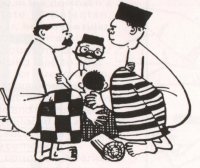 Lat's expression in his 1980's of the ceremony I went through in 1963, published in 1994 "Lat 30 Years Later" by Kampong Boy Sdn Bhd, Petaling Jaya. |
This was the biggest ceremony we ever had; many of my maternal relatives came to my home. I remembered in that fine sunny afternoon, when the time had come, my mother took me (and my brother) to the river for a bath with soap, and she watched us having our bath, with tear (of happiness) in her both eyes. Then it was performed by the well known TokMudim Man, assisted by Tok Bilal Llah, my brother first. It was all fine, and I was grounded for over a month in only a small locus. But tragically, a few days after the ceremony, my sister Aini (Zabedah), then closing to three, left us forever on my mother's lap after suffering from a quick fever due to a malignant tumor on her right thigh, aggravated by a munch of mutton she only tasted it during the ceremony made for me. It was in the late morning. She was not well since the day before, always crying, and was always on my mother's lap or 'dukung'; while MakDa Nab baby-sitted the several months old Rubaihah. Then suddenly my mother saw that Aini was in difficulty; she did not cry anymore. My mother took her into the house and asked me to call my father who then was at the back of the house. We were all sitting in the house, not very far from the entrance door, slightly further from the main column (tiang seri). Aini was on my mother's lap, I was on my mother's left side, and my father, reading verses of Quran, was in front of my mother during her final moment with us. She had our love and especially my mother's in the form of tears. Later I realised, that was the first time I saw how strong was my mother in facing her life, in facing the fact of loosing forever something she loved very much. Aini was the most loved by every body. My mother said, she was the most beautiful girl among my sisters. After she was bathed, I remembered MakNgah called every children around the house to have the last look at Aini. She was carried by my father, in a batik sling, down the house in a procession to the graveyard in Batu Enam. We all sent her to her final rest late in the evening, still in my 'ceremony garment', in Batu Enam, near Surau Pak Cha, where only until that day I knew where my grandfather (my father's father), Hj Ahmad was laid to rest, the place my father never failed to visit on the eve of every Eids and Eid Qurban, before and after this event, until he was made home-ridden. Aini was laid to rest beside her grandfather, who would surely love her very much more than we did, had they were given the same little times of life. We all reflected back on many times when Aini was ill. I saw my mother regretted her sometimes inpatience when Aini woke us up in the middle of the night or in the very early morning to ask for food, or to play, or simply to stay in unsleepy mood. We all remembered her particular say for "nasi" (I could not spell in roman here).
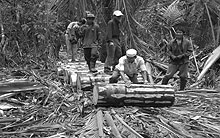 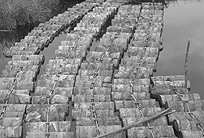 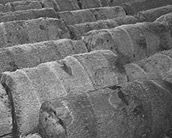 Sago grows wild in the swampy area of Tepoh. They were felled, cut smaller, and pushed to the nearest river; made into raft, and sailed down to the 'processing' jetty; |
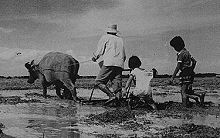 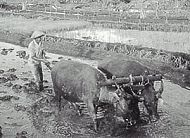 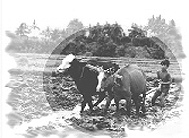 Every time when I came to know that Pak Itam Ghani was ploughing in Batas Pak Beng, my brother and I would run to see it, and when it came to grading stage, he would let us sit on the grader as the weight (instead of him standing on it). My father always 'paid' him to plough our field. One day in 1963, perhaps in Oct, when I was closing twelve, Pak Itam loaned all his 'equipments' and let me plough myself the field, on one condition: after the job, the bulls needed to be taken to place where they could feed on the best grass. |
I helped my father as much as I could. I helped my mother helping my father too. On several occasions I assisted Pektam Mezah who owned a cottage industry of making the sago powder from the trunk, for a small pay I would share with my family. I followed them up to Tepoh swamp and marshland to cut down the trees, then push into the river, gather them into a raft and 'sailed' down along the river to his jetty, about one hundred meters from my house. His son, Ripin was my folk-mate which I enjoyed very much growing up together. At one time I helped ploughing the plot my father used to grow padi near my house (batas Pak Beng), 'borrowing' all the apparatus from Pak Itam Ghani, including his pair of the giant bulls to pull the plough. The bull were so big that I almost lost control at one point on the way to return them back that they swayed into the padi fields of other people. Pak Itam, a distant relative of my father was very kind indeed to us. At about this time, a son of his nephew, who migrated to Sekinchan, Selangor, by the name Rashid, of about my age, came to stay with him to get his schooling in Tok Jiring. So with him, it was easier for Pak Itam to help me.
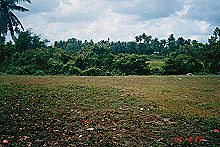 A place known at that time as 'Banggol', owned by Pak Itam, was for used by me, my brother and Rashid. In the late 1963, I grew water melon here, as a start to the thinking that I should commence my life. Down, in the swampy downhill was a well from which I shouldered the water in buckets uphill to water the melon plants, and some other vegetables. The harvest was not too good, but good enough for a boy as a start. This part of the land is now inherited by Utz Soh, Pak Itam's grandson who married my cousin, Fatimah, the daughter of MakTeh Pah, my father's younger sister. A hundred meters at the back of this spot was the shed (also belonged to Pak Itam) where I kept the five cows of Pak Su Mat Ibai that I reared, and the shed was shared with those of Pak Itam's, reared by Rashid. |
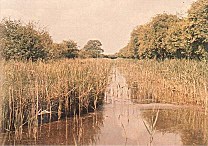 A place in the 'forest' called Tanjung Jaafar. I thought I had made a living here when I was twelve in 1963 by rearing cows in this area, with several other folk-kids; Rashid, Mat Selangor, Peing, and Him. It was a swampy area, ideal for cattle grazing. I would come here in the early morning with the cows, an hour walking, and back in the late evening. It practically took the cows to this place, let them graze while we were having our own frolicks: making a shed-hut (from gelam woods, peroi wall and roof, fixed with 'akar kendi', and 'anak kuat' floor, for us to rest and for the meal, or even nap, gathering 'akar kendi' for making ropes, and in the evening took them back to Banggul. Today, this place had mutated into a golf course and part of the airport after expansion in 1980's. This place is situated between Wakaf Baru and Wakaf Padang, off to the coast (east). |
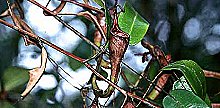 The ubiquitous periuk kera (pitcher plant) in the 'forest'. The pitcher is at the end of the leaf; it traps small insects such as ants and flies. But I was more interested in its stem, we made rope by weaving or spinning the cleaned stems. And the rope made from them were very strong. |
Depriving of the school activities, I obviously turned to the other side, to my working friends around Batu Enam. At first I was just following their outing to the 'forest' and had fun with the activities there, fishing, plucking wild fruits, collecting firewoods, or anything that could help my mother, and even began to grow some melon and vegetables, on a plot of land belonging to Pak Itam Ghani. With the rain began to fall in November, I did not feel very much the heat of the day. Later I felt my time could be optimised if I had a few cows that I could rear, the same routine done by them. It was a traditional arrangement that the people of Buluh Gading gave their animals to the people of the other side of the river to be reared, with a monthly fee, or on sibling sharing, during monsoon season because their place would be flooded. So I joined them. It happened that my mother had a relative, Pak Su Mat Ibai, exactly of that position. I took care all his cows, five of them, he gave me the 'sadat' as well to use, which I once cut my right palm while cutting the grass to feed the cows (I am a left-handed, but right-handed when writing.)
November and December gave me all the opportunities to taste how sweet or otherwise was to earn to feed. Very early in the morning, I left home on foot, out into the 'forest' with the folks, and come back only at almost dark, or at really dark. Usually my mother cooked for my packed-meal, the meal for the whole day.
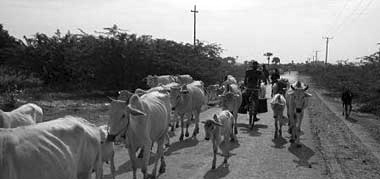 The fun in the morning into the grazing ground; and returned to the barn in the evening. A typical morning and evening scene along the road between Bt 6 and Wakaf Baru - Tg Jaafar. The 'path' was tarmac from early 1960s. The telephone poles were erected along; but the flora and fauna along it were untouched. The fun in the morning into the grazing ground; and returned to the barn in the evening. A typical morning and evening scene along the road between Bt 6 and Wakaf Baru - Tg Jaafar. The 'path' was tarmac from early 1960s. The telephone poles were erected along; but the flora and fauna along it were untouched. |
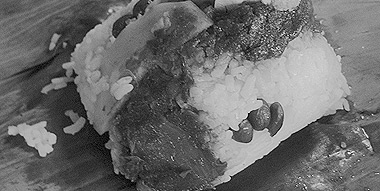 The pack lunch. Rice compacted with its accompaniments in the banana leave or in the recyclable "upih pinang". The pack lunch. Rice compacted with its accompaniments in the banana leave or in the recyclable "upih pinang".
|
It was during this period of my trial of life that the SSE results came out. It did not bothered me at all, and I had forgotten it altogether since my last day in the school in Aug. The joy or otherwise of other fellow friends who went to see the results were totally inexistence in my memories. However, the destiny took it course; CheGu Ismail found his way to my house and met my mother and told my mother my SSE results and explained to her what the results could be made to mean to me and to her too for the future. My mother did not tell me the first time he came, so I believed CheGu Ismail came many times to convince her, to tell her the choice I could have, to explain what it take, what to do and what would happen for each choice. My mother made the choice for me, the choice I would had made if I were directly asked by CheGu Ismail. He took all the particulars to take to the school to proceed, and eventually I was taken over by my destiny playing in the form of four elements: my father's confidence, my mother's prayer, CheGu Ismail's unprecedented sincere and persistent insistence, and my SSE result. I learned many years later that my mother was guided by her relatives in Mengabang Telung, who visited us once a while, in making her commitment to invest her effort on me, considering that this period was the hardest life she was in, but then she was in her late twenty, very energetic. The people of Mengabang Telong, despite in their poor fisherman life, especially the ladies, and more especially my mother's relatives were very concern about going to school, because they knew exactly what did going to school could mean to them.
In December, my mother made some 'preparations' for my new schooling. She did not touch my brother's 'earning', then already two years trying to live by her by doing anything a fourteen years old boy could do, like selling bread, selling local fruits, even selling fish at the Batu 6 market. He rode bicycle as far as Gemuruh to buy the fruits to sell at the market; everything of trading type, unlike me with more of routine type by gathering produce from the 'forest'. He actually concerned very much with my going further to school. But alas, it was not much of a preparation. I could still wear my white shirt from the std six. All I needed was a pair of white shoe and probably two pieces of white shorts (secondary school uniform). I bought the latter at Tepoh market from a few stalls I had long known selling used dresses. I picked the best: the one with the least number of patch places, or the least number of places to be patched. Abang Mat Pahang, happened to be 'balik kampung' helped me with a new white shirt. He took me, also to Tepoh market to buy it. I could not afford a trouser, and not even a casual shirt, undergarments were a wastage. I would wear school uniform all the time.
I returned the cows to the owner, thanking him very much for all the helps. I took my bath, deep in the river, cleaned myself from all the dirts and 'aroma', rinsed with fresh water and put on the school uniform again, this time uniform of another school, a new school in the next phase of life.
Edition dated May 2003.